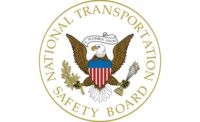Why flight lasted only 13 seconds

A fatigue crack was the cause of engine failure and a fire on a British Airways flight that ended prematurely, with passengers and crew fleeing a cockpit that was filling with smoke.
The September 8, 2015 flight from Las Vegas to London came to an abrupt end after its pilot heard a loud “bang” during takeoff and aborted the flight. The jetliner came to a stop on the runway 13 seconds later, but that didn’t bring an end to the emergency, according to a report issued by the National Transportation Safety Board (NTSB), which investigated the incident.
Only two of eight doors were usable
The captain ordered 157 passengers and 13 crew members to evacuate from the right side of the airplane. But the NTSB found that the unaffected right engine continued to run for 43 seconds after the captain’s order, resulting in jet blast blowing two emergency slides out of position and rendering them unusable for the evacuation. The passengers and crew were able to use two of the eight doors to leave the airplane before smoke and fire encroached the fuselage.
NTSB investigators determined that the engine fire was caused by a fatigue crack in the high-pressure compressor stage 8 disk web and subsequent uncontained engine failure, which led to the detachment of the main fuel supply line.
(In the NTSB photo above: the left engine of the 777-236ER after the fire.)
What the captain didn't do
The NTSB found that the captain did not use his quick reference handbook to read and do checklist items. It was only when a third pilot in the cockpit noticed instruments indicating the right engine was still running that the engine was shut down. “Because the captain did not follow standard procedures, his call for the evacuation checklist and the shutdown of the right engine were delayed,” the report said.
The high-pressure compressor stage 8-10 spool in the left engine, one of two GE GE90-85BG11 engines on the airplane, had accumulated 11,459 total cycles. Investigators found that the crack initiated after about 6,000 cycles, much earlier than the engine’s manufacturer, GE, predicted; the cause of the crack initiation could not be identified. There were no additional cracks found on the disk during a post-accident inspection of the engine.
The disk web was not an area that either the Federal Aviation Administration or the manufacturer required to be inspected, so the crack went undetected. During maintenance in September 2008, when the high-pressure compressor was removed from the engine and disassembled, exposing the stage 8-10 spool, the surface crack length would have been about 0.05 inches. “If the disk web had been required to be inspected during this maintenance, the crack should have been detectable,” the report said. The lack of inspection procedures for the stage 8 disk contributed to the accident, the NTSB found. After the accident, GE implemented inspection procedures designed to detect disk web cracks.
The full report can be found here or on NTSB.gov.
Looking for a reprint of this article?
From high-res PDFs to custom plaques, order your copy today!






